用STM32CubeMX和keil5组合,编出来的程序无论怎么查都找不出问题,头疼啊

没办法,找过一些程序作参考,但小白终究是小白,还是调不出来,正当我要放弃的时候,突然想起在查找板子相关资料的时候发现这个板子是可以支持mebd项目中的在线开发环境的,我要是从那个方向下手,换个程序编会不会成功呢,与其纠缠在原来的程序中,倒不如尝试一下新的编程方式。
说干就干。首先,点开mbed在线调试。
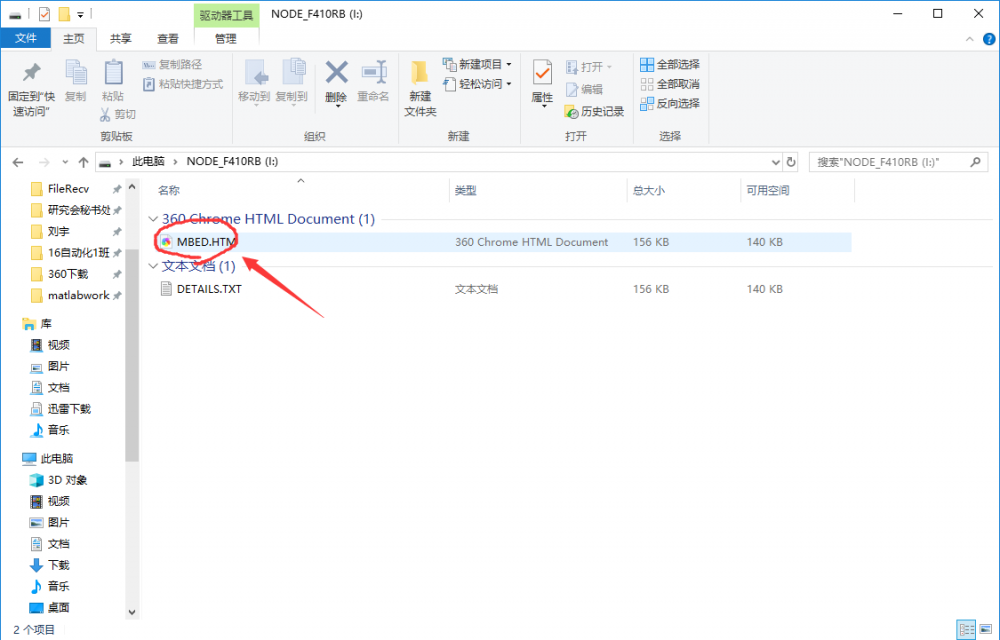
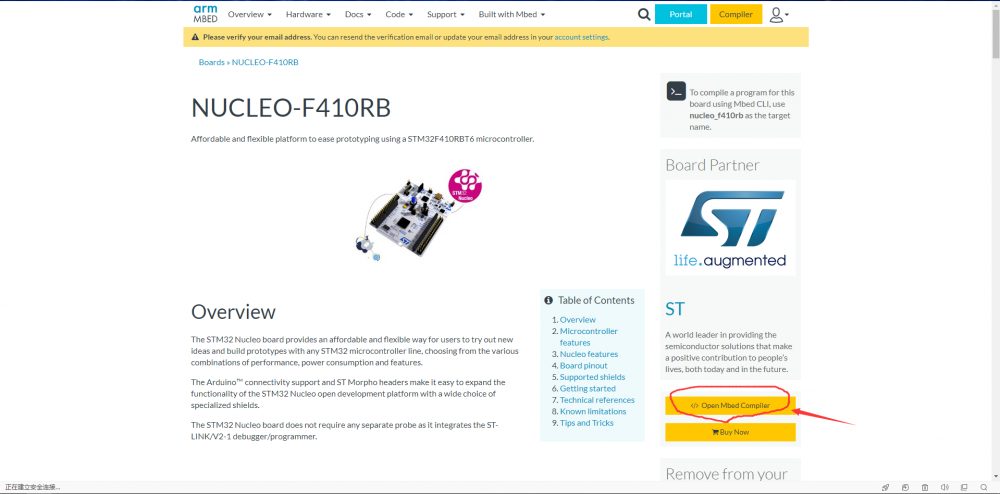
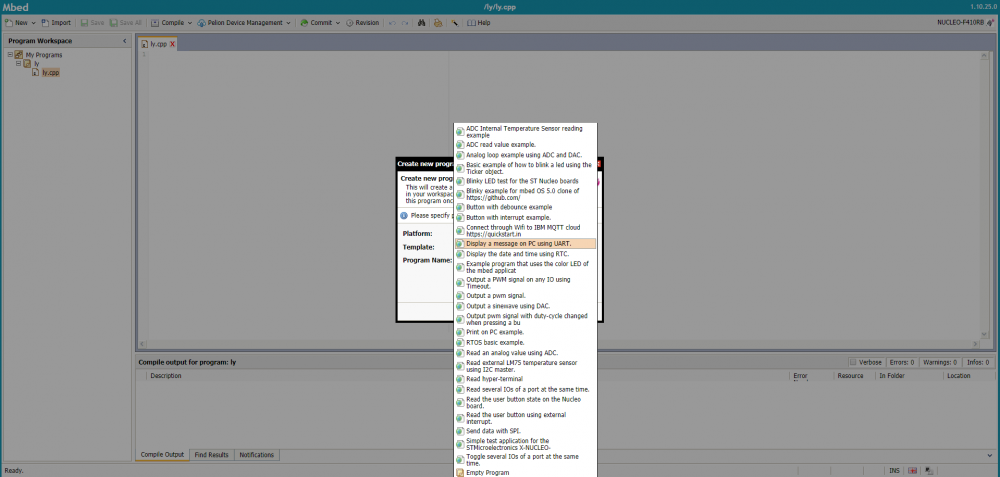
第一次使用需要注册,注册完直接登录,创建工程。可以直接导入创建例程工程。随便选择一个,点击“OK”创建工程,直接打开main.c文件。
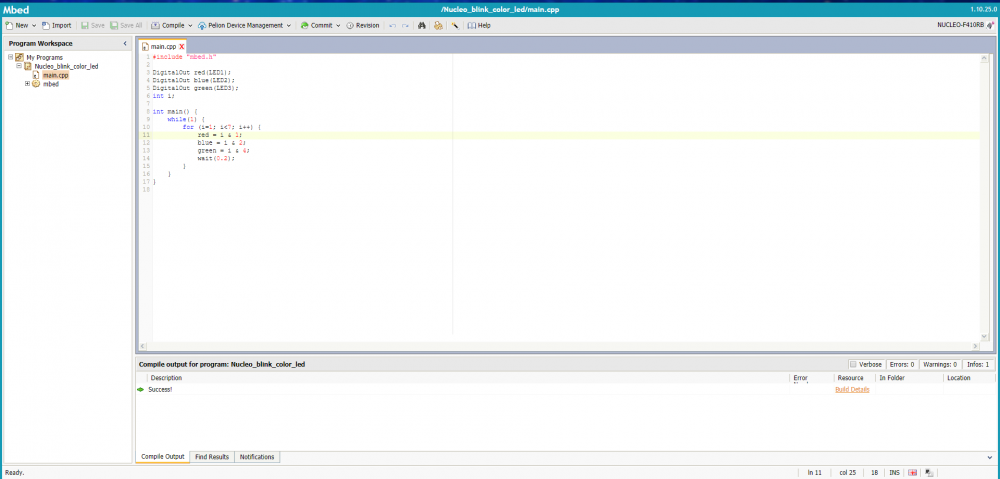
可以看到直接就有例程了,咱们的项目用不到,直接全选删除即可。
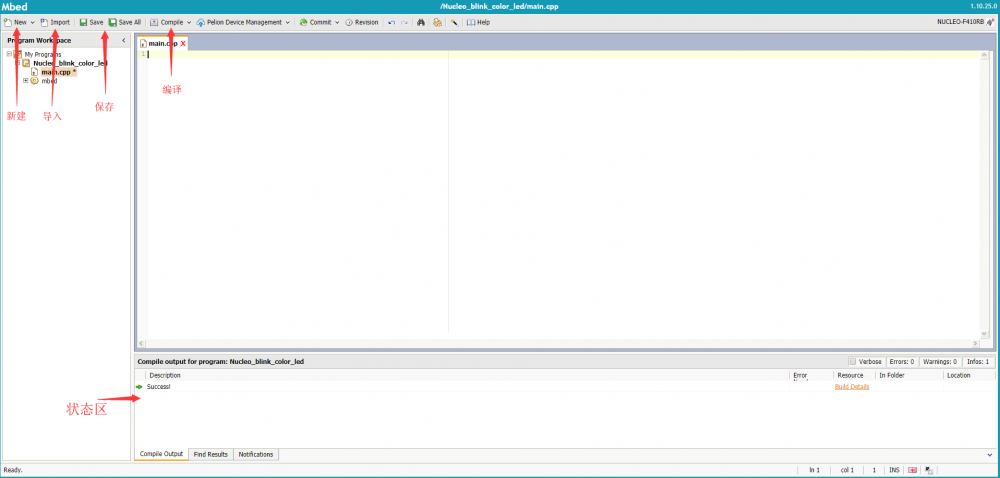
界面比较简洁,一看就懂。
加入程序。
#include "mbed.h"
#define false 0
#define true 1
Ticker tick;
DigitalOut leds(D12);
DigitalOut led1(LED1);
AnalogIn pulsepin(A0);//analog input pin
Serial pc(SERIAL_TX, SERIAL_RX);//USB TO SERIAL
// these variables are volatile because they are used during the shorterrupt service routine!
volatile short BPM; // used to hold the pulse rate
volatile short Signal; // holds the incoming raw data
volatile short IBI = 600; // holds the time between beats, must be seeded!
volatile char Pulse = false; // true when pulse wave is high, false when it's low
volatile char QS = false; // becomes true when Arduoino finds a beat.
volatile short rate[10]; // array to hold last ten IBI values
volatile unsigned long sampleCounter = 0; // used to determine pulse timing
volatile unsigned long lastBeatTime = 0; // used to find IBI
volatile short P =512; // used to find peak in pulse wave, seeded
volatile short T = 512; // used to find trough in pulse wave, seeded
volatile short thresh = 512; // used to find instant moment of heart beat, seeded
volatile short amp = 100; // used to hold amplitude of pulse waveform, seeded
volatile char firstBeat = true; // used to seed rate array so we startup with reasonable BPM
volatile char secondBeat = false; // used to seed rate array so we startup with reasonable BPM
//void ledFadeToBeat()
//{
// fadeRate -= 15; // set LED fade value
// fadeRate = constrain(fadeRate,0,255); // keep LED fade value from going shorto negative numbers!
// analogWrite(fadePin,fadeRate); // fade LED
//}
void timer_isr(void)
{
//cli(); // disable shorterrupts while we do this
Signal = pulsepin.read_u16()>>6; // read the Pulse Sensor
sampleCounter += 2; // keep track of the time in mS with this variable
short N = sampleCounter - lastBeatTime; // monitor the time since the last beat to avoid noise
// find the peak and trough of the pulse wave
if(Signal < thresh && N > (IBI/5)*3) { // avoid dichrotic noise by waiting 3/5 of last IBI
if (Signal < T) { // T is the trough
T = Signal; // keep track of lowest poshort in pulse wave
}
}
if(Signal > thresh && Signal > P) { // thresh condition helps avoid noise
P = Signal; // P is the peak
} // keep track of highest poshort in pulse wave
// NOW IT'S TIME TO LOOK FOR THE HEART BEAT
// signal surges up in value every time there is a pulse
if (N > 250) { // avoid high frequency noise
if ( (Signal > thresh) && (Pulse == false) && (N > (IBI/5)*3) ) {
Pulse = true; // set the Pulse flag when we think there is a pulse
leds=1; // turn on pin 13 LED
IBI = sampleCounter - lastBeatTime; // measure time between beats in mS
lastBeatTime = sampleCounter; // keep track of time for next pulse
if(secondBeat) { // if this is the second beat, if secondBeat == TRUE
secondBeat = false; // clear secondBeat flag
for(short i=0; i<=9; i++) { // seed the running total to get a realisitic BPM at startup
rate[i] = IBI;
}
}
if(firstBeat) { // if it's the first time we found a beat, if firstBeat == TRUE
firstBeat = false; // clear firstBeat flag
secondBeat = true; // set the second beat flag
//sei(); // enable shorterrupts again
return; // IBI value is unreliable so discard it
}
// keep a running total of the last 10 IBI values
unsigned short runningTotal = 0; // clear the runningTotal variable
for(short i=0; i<=8; i++) { // shift data in the rate array
rate[i] = rate[i+1]; // and drop the oldest IBI value
runningTotal += rate[i]; // add up the 9 oldest IBI values
}
rate[9] = IBI; // add the latest IBI to the rate array
runningTotal += rate[9]; // add the latest IBI to runningTotal
runningTotal /= 10; // average the last 10 IBI values
BPM = 60000/runningTotal; // how many beats can fit shorto a minute? that's BPM!
QS = true; // set Quantified Self flag
// QS FLAG IS NOT CLEARED INSIDE THIS ISR
}
}
if (Signal < thresh && Pulse == true) { // when the values are going down, the beat is over
leds=0; // turn off pin 13 LED
Pulse = false; // reset the Pulse flag so we can do it again
amp = P - T; // get amplitude of the pulse wave
thresh = amp/2 + T; // set thresh at 50% of the amplitude
P = thresh; // reset these for next time
T = thresh;
}
if (N > 2500) { // if 2.5 seconds go by without a beat
thresh = 512; // set thresh default
P = 512; // set P default
T = 512; // set T default
lastBeatTime = sampleCounter; // bring the lastBeatTime up to date
firstBeat = true; // set these to avoid noise
secondBeat = false; // when we get the heartbeat back
}
//sei(); // enable shorterrupts when youre done!
}
void sendDataToProcessing(char symbol, short data )
{
pc.putc(symbol); // symbol prefix tells Processing what type of data is coming
pc.printf("%d\r\n", data); // the data to send culminating in a carriage return
}
int main()
{
pc.baud(115200); // we agree to talk fast!
tick.attach_us(&timer_isr,2000); // sets up to read Pulse Sensor signal every 2mS
while(1) {
led1 =1;
sendDataToProcessing('S', Signal); // send Processing the raw Pulse Sensor data
if (QS == true) { // Quantified Self flag is true when arduino finds a heartbeat
//fadeRate = 255; // Set 'fadeRate' Variable to 255 to fade LED with pulse
sendDataToProcessing('B',BPM); // send heart rate with a 'B' prefix
sendDataToProcessing('Q',IBI); // send time between beats with a 'Q' prefix
QS = false; // reset the Quantified Self flag for next time
}
//ledFadeToBeat();
wait(0.02); // take a break
}
}
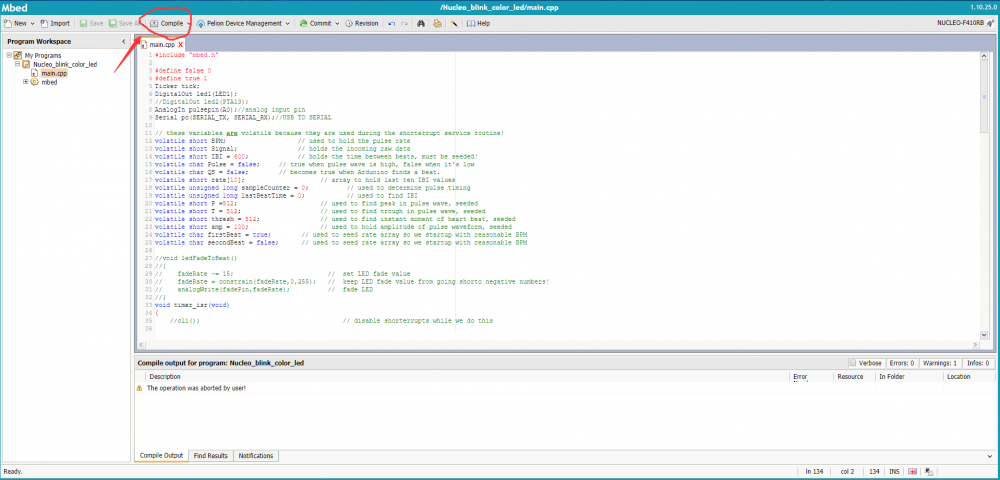
点击编译,会弹出窗口,等编译完,会提示下载,直接选择板子内存,下载进去就行。
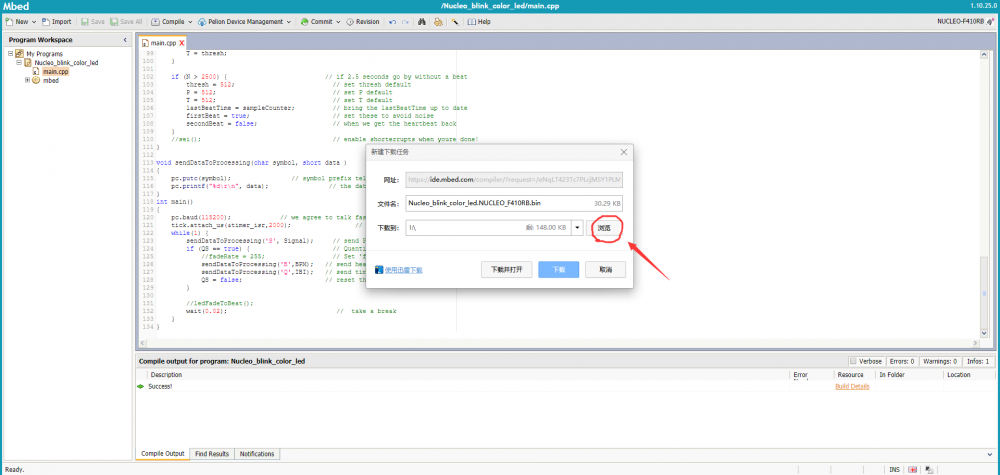
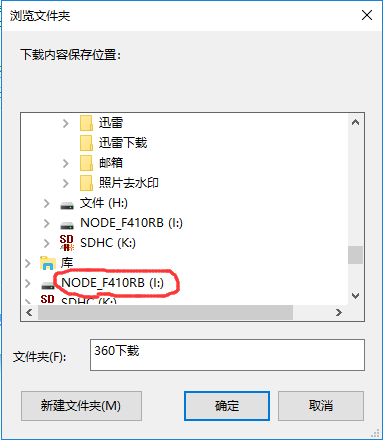
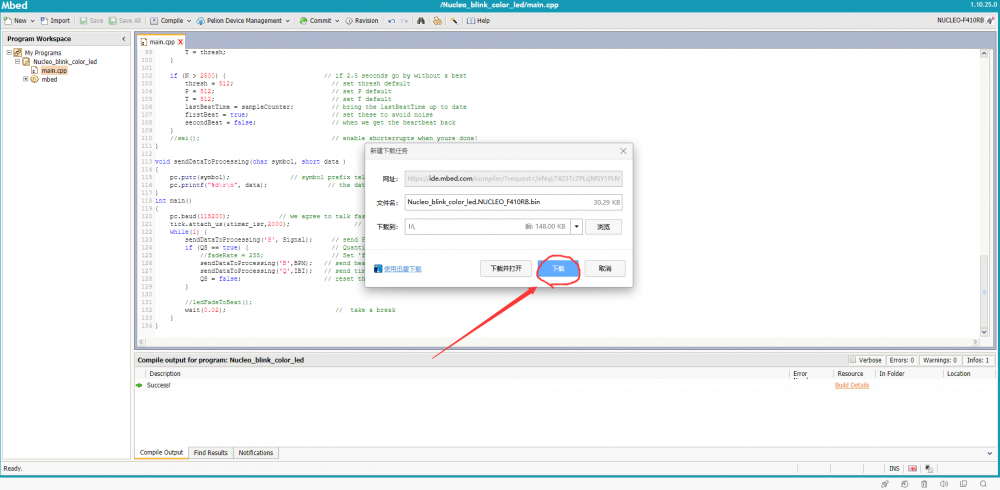
下栽进去后板子上的程序就会自动运行了。
对了,引脚接法是
pulse sensor:
VOUT -> PA0
VCC <- 3.3V
GND <- GND
LED小灯:
VOUT -> PA5
VCC <- 5V
GND <- GND
运行效果如下图,我的心在那跳动

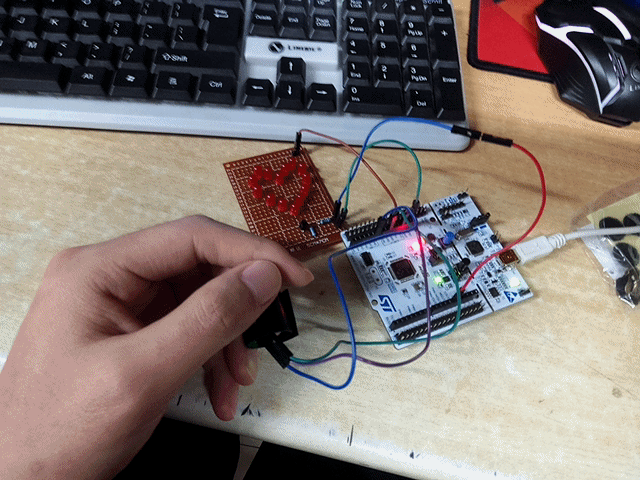
我用找到的心率传感器上位机显示程序processing显示如下图。

换了一种方法,果然成功了。LED小灯闪烁频率和我的心跳一样,“跳动的心”终于跳动起来了,实现了功能。不容易啊,以前玩c51系列的,初碰stm32,还是挺有难度的,我发现,实际上,论坛上的资源还是挺多的,只是有些程序比较难读,不同型号的板子之间的联系和代码替换相关的帖子也比较少,在查找上还不是那么方便。至此,我的“跳动的心”就告一段落了,真心感谢论坛给我这次机会,也感谢在我遇到困难时对我给予帮助的小伙伴们!
PS:如果有哪位大神知道我用keil5编写的程序问题在哪,或者有对我的程序有兴趣的小伙伴,欢迎指教哦

我把PulseSensor的相关资料和显示程序链接附上,需要的自取吧。
链接:https://pan.baidu.com/s/1G-tCvMk8MdAT8EDx_KjUCQ
提取码:gngs
